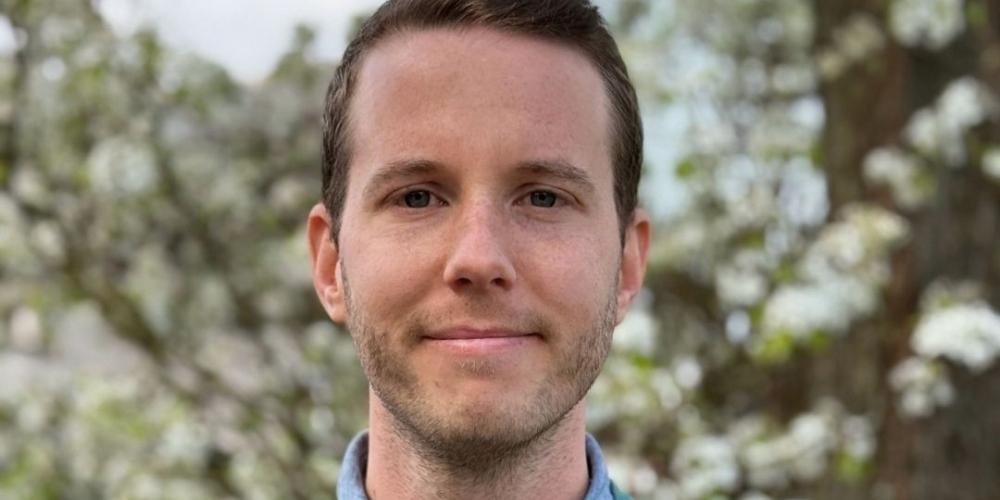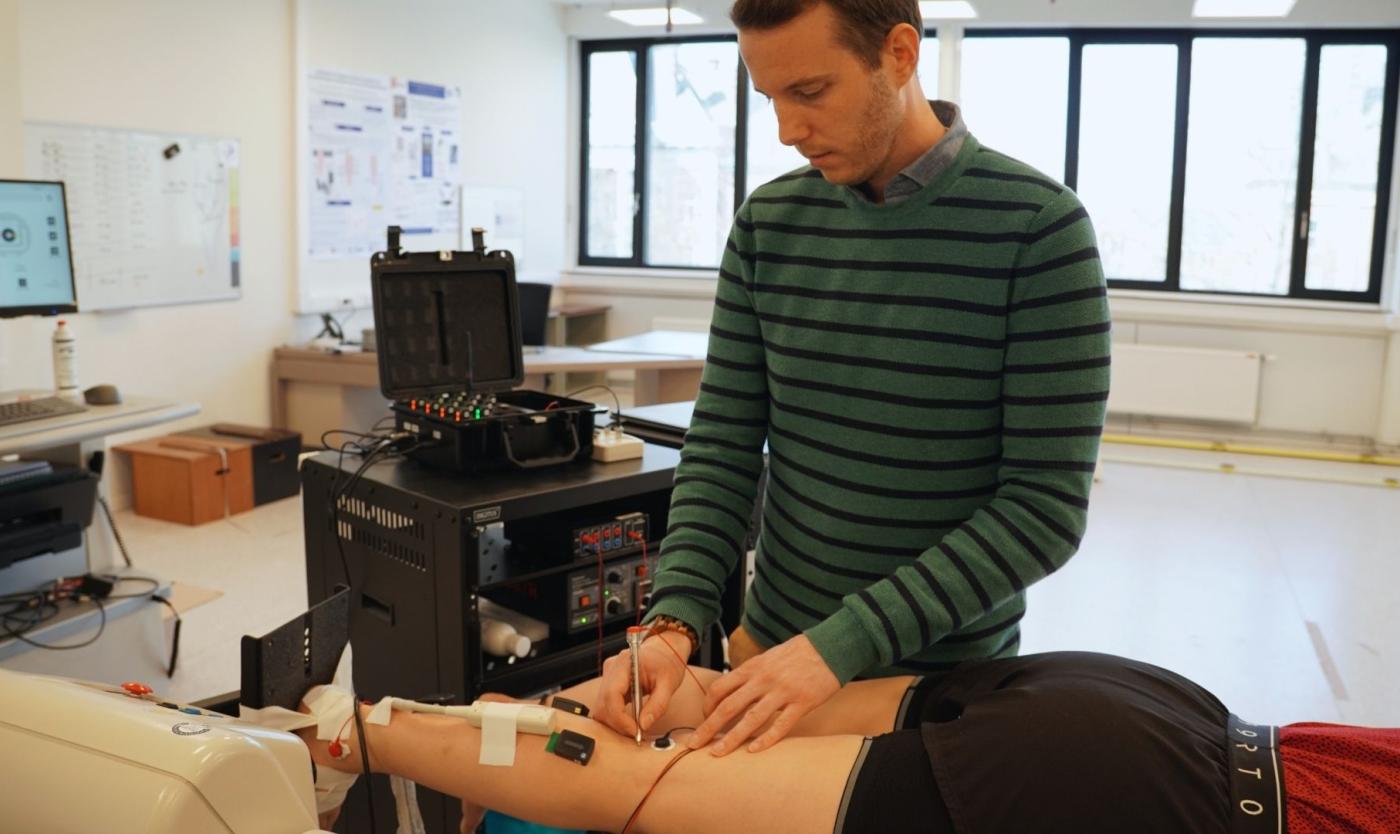
Jumping like a frog. Walking on air. Rehabilitating with robotic arms. Muscles and tendons — and the way they work together — are the engine of the human body. As a biomechanist, VUB Professor Jeroen Aeles investigates how this intricate mechanism functions, and what it could mean for elite sport, rehabilitation, super-shoes and robotics.
To start with: how many muscles and tendons does a human being have?
Jeroen Aeles: “On average we have between 600 and 650 muscles, most of them skeletal muscles — the ones you can consciously control, like those in your arms and legs. Each muscle is attached to at least one tendon, usually two. Roughly speaking, that gives us around 1,200 tendons in the body.”
You study these muscles and tendons. What does that research involve in practice?
“We look at how muscles and tendons bring us into motion. That begins with the basics — what a muscle looks like — right up to how muscle force is generated and how that plays out in, for instance, elite athletes, but also in people with injuries or neurological conditions. The interaction between muscles and tendons is especially fascinating, because they’re completely different structures. A muscle actively contracts to generate force, whereas a tendon behaves more like a passive elastic band. Their collaboration is extremely precise. Take a frog, for example. It can jump far higher than its muscle strength alone would suggest, thanks to the spring-like tendons in its hind legs. Those tendons store energy as the legs bend and release it during extension, producing a much more powerful jump. The same process happens in humans.”
You use techniques such as ultrasound, MRI and electrical stimulation. How exactly does that work?
“When people think of ultrasound, they usually picture scans of an unborn baby. Sports doctors also use it frequently to identify muscle or tendon tears. In our lab we use a slightly different form of ultrasound, with flat probes that can, for instance, be fixed to the lower leg. This lets us track how a muscle shortens or lengthens. With animals we also use imaging techniques such as CT scans and X-rays. One of our main ambitions is to refine these technologies further. That innovative aspect is very important to us.”

How do you translate this research into practice?
“During my PhD I examined the explosive movements of elite athletes, and particularly the interaction between their muscles and tendons. We found that you can indeed improve that interaction through training: muscles grow larger and stronger, allowing more elastic energy to be stored in the tendons and then released. On the other hand, we also study how muscles and tendons work in people with injuries or neurological disorders. Where is the disruption? How did it arise? That’s vital research for supporting both surgery and rehabilitation.”
"Als ik over mijn onderzoek vertel, denkt 90 procent van de mensen dat ik spieren onderzoek bij krachttraining of in de fitness"
Running is hugely popular these days. Does your research help in the search for the ‘ideal’ running shoe?
“The ideal running shoe is different for everyone — and it doesn’t necessarily have to be the most expensive one. Why? Because movement is unique. Each of us moves in our own way. We’ve shown this at the muscle level: everyone has a different muscle structure, tendon stiffness, lever arms and so on. That means there’s no such thing as a universal ‘best’ shoe. It depends on individual needs — from injury prevention to performance enhancement. That said, there are certain standard features that do make a difference. Take the so-called ‘super-shoes’ that appeared a few years ago. The Nike Vaporfly is a good example. With its special carbon plate and extremely light weight, it reduces elite runners’ energy use by around four per cent. That can definitely affect race outcomes — we know this from scientific research by my colleague Professor Wouter Hoogkamer (then at the University of Colorado Boulder, now University of Massachusetts Amherst). I’d like to go a step further and study whether such shoes also influence muscle–tendon dynamics. From an engineering perspective, we know the shoe stores and releases elastic energy with every step — just like the interaction between muscles and tendons. Does the shoe partly take over their role, or does it optimise their cooperation? That’s a line of research I’d love to pursue, but it isn’t being done yet.”
Barefoot running is also trendy. Is there a balance between natural running and high-tech support?
“There are conflicting views on that. Some argue that barefoot running is the way forward because it’s more natural and helps develop muscles. Other studies suggest it actually hinders muscle function and increases the risk of injury. Again, it’s highly individual. Some people thrive running barefoot, while others clearly need cushioning and support.”
What are the biggest misconceptions about muscles and tendons?
“Many people don’t realise that tendons contribute to movement. Yet they’re essential — not only for explosive actions but even for simple walking. The complexity of muscles is often underestimated too. When I talk about my work, nine out of ten people assume I’m studying bodybuilding or gym training. In reality, a muscle can contract and generate force in a thousand different ways. It’s not just a motor for the body — it can act as a spring, a shock absorber, a strut, a force transmitter...”
Looking ahead, what is your biggest professional drive?
“My main focus right now is muscle architecture, which remains surprisingly poorly understood. When I ask our students to draw a muscle, they usually sketch an oval with tendons at either end. But that’s completely wrong. I often show them an MRI image of an actual muscle: bulbous at one end, highly irregular in shape. Each muscle has its own architecture, which likely varies significantly not only between humans but also across different animals. It’s a field where we still have almost carte blanche, and where I want to concentrate my efforts in the coming years — especially on understanding the functional role of muscle shape.”
And how might that benefit us in the long run?
“It has huge potential. Understanding how movement arises — both in healthy people and in patients with injuries — is fundamental. But it could also improve the design of exoskeletons and assistive devices in hospitals, making them better suited to the body’s underlying muscle architecture. For lab-grown muscles and robotics, this knowledge is just as essential.”
Bio Jeroen Aeles
Professor Dr Jeroen Aeles is Professor of Biomechanics at the Faculty of Physical Education and Physiotherapy at the VUB. He is head of the Brussels Neuromuscular Biomechanics Laboratory and operational director of the core facility Brubotics Rehabilitation Research Centre. He is also affiliated with the University of Antwerp, Department of Biology, for his research on animals.